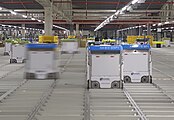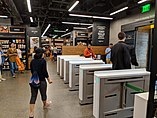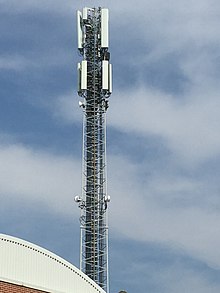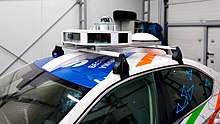The Fourth Industrial Revolution, 4IR, or Industry 4.0 conceptualizes rapid change to technology, industries, and societal patterns and processes in the 21st century due to increasing interconnectivity and smart automation. Coined popularly by the World Economic Forum Founder and Executive Chairman, Klaus Schwab, it asserts that the changes seen are more than just improvements to efficiency, but express a significant shift in industrial capitalism.
A part of this phase of industrial change is the joining of technologies like artificial intelligence, gene editing, to advanced robotics that blur the lines between the physical, digital, and biological worlds.
Throughout this, fundamental shifts are taking place in how the global production and supply network operates through ongoing automation of traditional manufacturing and industrial practices, using modern smart technology, large-scale machine-to-machine communication (M2M), and the internet of things (IoT). This integration increasing automation, improving communication and self-monitoring, and the use of smart machines that can analyze and diagnose issues without the need for human intervention.
It also represents a social, political, and economic shift from the digital age of the late 1990s and early 2000s to an era of embedded connectivity distinguished by the omni-use and commonness of technological use throughout society (e.g. a metaverse) that changes the ways we experience and know the world around us. That we have created and are entering an augmented social reality compared to just the natural senses and industrial ability of humans alone.
History
The phrase Fourth Industrial Revolution was first introduced by a team of scientists developing a high-tech strategy for the German government. Klaus Schwab, executive chairman of the World Economic Forum (WEF), introduced the phrase to a wider audience in a 2015 article published by Foreign Affairs. "Mastering the Fourth Industrial Revolution" was the 2016 theme of the World Economic Forum Annual Meeting, in Davos-Klosters, Switzerland.
On the 10 October, 2016, the Forum announced the opening of its Centre for the Fourth Industrial Revolution in San Francisco. This was also subject and title of Schwab's 2016 book. Schwtab includes in this fourth era technologies that combine hardware, software, and biology (cyber-physical systems), and emphasizes advances in communication and connectivity. Schwab expects this era to be marked by breakthroughs in emerging technologies in fields such as robotics, artificial intelligence, nanotechnology, quantum computing, biotechnology, the internet of things, the industrial internet of things, decentralized consensus, fifth-generation wireless technologies, 3D printing, and fully autonomous vehicles.
In The Great Reset proposal by the WEF, The Fourth Industrial Revolution is included as a Strategic Intelligence in the solution to rebuild the economy sustainably following the COVID-19 pandemic.
First Industrial Revolution
The First Industrial Revolution was marked by a transition from hand production methods to machines through the use of steam power and water power. The implementation of new technologies took a long time, so the period which this refers to was between 1760 and 1820, or 1840 in Europe and the United States. Its effects had consequences on textile manufacturing, which was first to adopt such changes, as well as iron industry, agriculture, and mining although it also had societal effects with an ever stronger middle class. It also had an effect on British industry at the time.
Second Industrial Revolution
The Second Industrial Revolution, also known as the Technological Revolution, is the period between 1871 and 1914 that resulted from installations of extensive railroad and telegraph networks, which allowed for faster transfer of people and ideas, as well as electricity. Increasing electrification allowed for factories to develop the modern production line. It was a period of great economic growth, with an increase in productivity, which also caused a surge in unemployment since many factory workers were replaced by machines.
Third Industrial Revolution
The Third Industrial Revolution, also known as the Digital Revolution, occurred in the late 20th century, after the end of the two world wars, resulting from a slowdown of industrialization and technological advancement compared to previous periods. The production of the Z1 computer, which used binary floating-point numbers and Boolean logic, a decade later, was the beginning of more advanced digital developments. The next significant development in communication technologies was the supercomputer, with extensive use of computer and communication technologies in the production process; machinery began to abrogate the need for human power.
Fourth Industrial Revolution
In essence, the Fourth Industrial Revolution is the trend towards automation and data exchange in manufacturing technologies and processes which include cyber-physical systems (CPS), IoT, industrial internet of things, cloud computing, cognitive computing, and artificial intelligence.
The Fourth Industrial Revolution marks the beginning of the Imagination Age.
Key themes
Four themes are presented that summarize an Industry 4.0:
- Interconnection — the ability of machines, devices, sensors, and people to connect and communicate with each other via the Internet of things, or the internet of people (IoP)
- Information transparency — the transparency afforded by Industry 4.0 technology provides operators with comprehensive information to make decisions. Inter-connectivity allows operators to collect immense amounts of data and information from all points in the manufacturing process, identify key areas that can benefit from improvement to increase functionality
- Technical assistance — the technological facility of systems to assist humans in decision-making and problem-solving, and the ability to help humans with difficult or unsafe tasks
- Decentralized decisions — the ability of cyber physical systems to make decisions on their own and to perform their tasks as autonomously as possible. Only in the case of exceptions, interference, or conflicting goals, are tasks delegated to a higher level
Distinctiveness
Proponents of the Fourth Industrial Revolution suggest it is a distinct revolution rather than simply a prolongation of the Third Industrial Revolution. This is due to the following characteristics:
- Velocity — exponential speed at which incumbent industries are affected and displaced
- Scope and systems impact - the large amount of sectors and firms that are affected
- Paradigm shift in technology policy — new policies designed for this new way of doing are present. An example is Singapore's formal recognition of Industry 4.0 in its innovation policies.
Critics of the concept dismiss Industry 4.0 as a marketing strategy. They suggest that although revolutionary changes are identifiable in distinct sectors, there is no systemic changes so far. In addition, the pace of recognition of Industry 4.0 and policy transition varies across countries; the definition of Industry 4.0 is not harmonized.
Components
The application of the Fourth Industrial Revolution operates through:
- Mobile devices
- Internet of things (IoT) platforms
- Location detection technologies (electronic identification)
- Advanced human-machine interfaces
- Authentication and fraud detection
- Smart sensors
- Big analytics and advanced processes
- Multilevel customer interaction and customer profiling
- Augmented reality/ wearables
- On-demand availability of computer system resources
- Data visualization and triggered "live" training
Mainly these technologies can be summarized into four major components, defining the term “Industry 4.0” or “smart factory”:
- Cyber-physical systems
- Internet of things (IoT)
- On-demand availability of computer system resources
- Cognitive computing
Industry 4.0 networks a wide range of new technologies to create value. Using cyber-physical systems that monitor physical processes, a virtual copy of the physical world can be designed. Characteristics of cyber-physical systems include the ability to make decentralized decisions independently, reaching a high degree of autonomy.
The value created in Industrie 4.0, can be relied upon electronic identification, in which the smart manufacturing require set technologies to be incorporated in the manufacturing process to thus be classified as in the development path of Industrie 4.0 and no longer digitisation.
Primary drivers
Digitization and integration of vertical and horizontal value chains
Industry 4.0 integrates processes vertically, across the entire organization, including processes in product development, manufacturing, structuring, and service; horizontally, Industry 4.0 includes internal operations from suppliers to customers as well as all key value chain partners.
Digitization of product and services
Integrating new methods of data collection and analysis–such as through the expansion of existing products or creation of new digitized products–helps companies to generate data on product use in order to refine products.
Digital business models and customer access
Customer satisfaction is a perpetual, multi-stage process that requires modification in real-time to adapt to the changing needs of consumers.
Trends
Smart factory
Smart Factory is the vision of a production environment in which production facilities and logistics systems are organized without human intervention.
The Smart Factory is no longer a vision. While different model factories represent the feasible, many enterprizes already clarify with examples practically, how the Smart Factory functions.
The technical foundations on which the Smart Factory - the intelligent factory - is based are cyber-physical systems that communicate with each other using the Internet of Things and Services. An important part of this process is the exchange of data between the product and the production line. This enables a much more efficient connection of the Supply Chain and better organisation within any production environment.
The Fourth Industrial Revolution fosters what has been called a "smart factory". Within modular structured smart factories, cyber-physical systems monitor physical processes, create a virtual copy of the physical world and make decentralized decisions. Over the internet of things, cyber-physical systems communicate and cooperate with each other and with humans in synchronic time both internally and across organizational services offered and used by participants of the value chain.
Predictive maintenance
Industry 4.0 can also provide predictive maintenance, due to the use of technology and the IoT sensors. Predictive maintenance – which can identify maintenance issues in live – allows machine owners to perform cost-effective maintenance and determine it ahead of time before the machinery fails or gets damaged. For example, a company in Los Angeles could understand if a piece of equipment in Singapore is running at an abnormal speed or temperature. They could then decide whether or not it needs to be repaired.
3D printing
The Fourth Industrial Revolution is said to have extensive dependency on 3D printing technology. Some advantages of 3D printing for industry are that 3D printing can print many geometric structures, as well as simplify the product design process. It is also relatively environmentally friendly. In low-volume production, it can also decrease lead times and total production costs. Moreover, it can increase flexibility, reduce warehousing costs and help the company towards the adoption of a mass customization business strategy. In addition, 3D printing can be very useful for printing spare parts and installing it locally, therefore reducing supplier dependence and reducing the supply lead time.
The determining factor is the pace of change. The correlation of the speed of technological development and, as a result, socio-economic and infrastructural transformations with human life allow us to state a qualitative leap in the speed of development, which marks a transition to a new time era.
Smart sensors
Sensors and instrumentation drive the central forces of innovation, not only for Industry 4.0 but also for other “smart” megatrends, such as smart production, smart mobility, smart homes, smart cities, and smart factories.
Smart sensors are devices, which generate the data and allow further functionality from self-monitoring and self-configuration to condition monitoring of complex processes. With the capability of wireless communication, they reduce installation effort to a great extent and help realize a dense array of sensors.
The importance of sensors, measurement science, and smart evaluation for Industry 4.0 has been recognized and acknowledged by various experts and has already led to the statement "Industry 4.0: nothing goes without sensor systems."
However, there are few issues, such as time synchronization error, data loss, and dealing with large amounts of harvested data, which all limit the implementation of full-fledged systems. Moreover, additional limits on these functionalities represents the battery power. One example of the integration of smart sensors in the electronic devices, is the case of smart watches, where sensors receive the data from the movement of the user, process the data and as a result, provide the user with the information about how many steps they have walked in a day and also converts the data into calories burned.
Agriculture and Food Industries
Smart sensors in these two fields are still in the testing stage. These innovative connected sensors collect, interpret and communicate the information available in the plots (leaf area, vegetation index, chlorophyll, hygrometry, temperature, water potential, radiation). Based on this scientific data, the objective is to enable real-time monitoring via a smartphone with a range of advice that optimizes plot management in terms of results, time and costs. On the farm, these sensors can be used to detect crop stages and recommend inputs and treatments at the right time. As well as controlling the level of irrigation.
The food industry requires more and more security and transparency and full documentation is required. This new technology is used as a tracking system as well as the collection of human data and product data.
Accelerated transition to the knowledge economy
Knowledge economy is an economic system in which production and services are largely based on knowledge-intensive activities that contribute to an accelerated pace of technical and scientific advance, as well as rapid obsolescence. Industry 4.0 aids transitions into knowledge economy by increasing reliance on intellectual capabilities than on physical inputs or natural resources.
Challenges
Challenges in implementation of Industry 4.0:
Economic
- High economic costs
- Business model adaptation
- Unclear economic benefits/excessive investment
Social
- Privacy concerns
- Surveillance and distrust
- General reluctance to change by stakeholders
- Threat of redundancy of the corporate IT department
- Loss of many jobs to automatic processes and IT-controlled processes, especially for blue collar workers
- Increased risk of gender inequalities in professions with job roles most susceptible to replacement with AI
Political
- Lack of regulation, standards and forms of certifications
- Unclear legal issues and data security
Organizational
- IT security issues, which are greatly aggravated by the inherent need to open up previously closed production shops
- Reliability and stability needed for critical machine-to-machine communication (M2M), including very short and stable latency times
- Need to maintain the integrity of production processes
- Need to avoid any IT snags, as those would cause expensive production outages
- Need to protect industrial know-how (contained also in the control files for the industrial automation gear)
- Lack of adequate skill-sets to expedite the transition towards a fourth industrial revolution
- Low top management commitment
- Insufficient qualification of employees
Country applications
Many countries have set up institutional mechanisms to foster the adoption of Industry 4.0 technologies. For example,
Australia
Australia has a Digital Transformation Agency (est. 2015) and the Prime Minister’s Industry 4.0 Taskforce (est. 2016), which promotes collaboration with industry groups in Germany and the USA.
Germany
The term "Industrie 4.0", shortened to I4.0 or simply I4, originated in 2011 from a project in the high-tech strategy of the German government and specifically relates to that project policy, rather than a wider notion of a Fourth Industrial Revolution of 4IR. which promotes the computerization of manufacturing. The term "Industrie 4.0" was publicly introduced in the same year at the Hannover Fair. Renowned German professor Wolfgang Wahlster is sometimes called the inventor of the "Industry 4.0" term. In October 2012, the Working Group on Industry 4.0 presented a set of Industry 4.0 implementation recommendations to the German federal government. The workgroup members and partners are recognized as the founding fathers and driving force behind Industry 4.0. On 8 April 2013 at the Hannover Fair, the final report of the Working Group Industry 4.0 was presented. This working group was headed by Siegfried Dais, of Robert Bosch GmbH, and Henning Kagermann, of the German Academy of Science and Engineering.
As Industry 4.0 principles have been applied by companies, they have sometimes been rebranded. For example, the aerospace parts manufacturer Meggitt PLC has branded its own Industry 4.0 research project M4.
The discussion of how the shift to Industry 4.0, especially digitization, will affect the labour market is being discussed in Germany under the topic of Work 4.0.
The characteristics of the German government's Industry 4.0 strategy involve the strong customization of products under the conditions of highly flexible (mass-) production. The required automation technology is improved by the introduction of methods of self-optimization, self-configuration, self-diagnosis, cognition and intelligent support of workers in their increasingly complex work. The largest project in Industry 4.0 as of July 2013 is the German Federal Ministry of Education and Research (BMBF) leading-edge cluster "Intelligent Technical Systems Ostwestfalen-Lippe (its OWL)". Another major project is the BMBF project RES-COM, as well as the Cluster of Excellence "Integrative Production Technology for High-Wage Countries". In 2015, the European Commission started the international Horizon 2020 research project CREMA (Providing Cloud-based Rapid Elastic Manufacturing based on the XaaS and Cloud model) as a major initiative to foster the Industry 4.0 topic.
Indonesia
Another example is Making Indonesia 4.0, with a focus on improving industrial performance.
South Africa
South Africa appointed a Presidential Commission on the Fourth Industrial Revolution in 2019, consisting of about 30 stakeholders with a background in academia, industry and government. South Africa has also established an Interministerial Committee on Industry 4.0.
South Korea
The Republic of Korea has had a Presidential Committee on the Fourth Industrial Revolution since 2017. The Republic of Korea’s I-Korea strategy (2017) is focusing on new growth engines that include AI, drones and autonomous cars, in line with the government’s innovation-driven economic policy.
Uganda
Uganda adopted its own National 4IR Strategy in October 2020 with emphasis on e-governance, urban management (smart cities), health care, education, agriculture and the digital economy; to support local businesses, the government was contemplating introducing a local start-ups bill in 2020 which would require all accounting officers to exhaust the local market prior to procuring digital solutions from abroad.
United Kingdom
In a policy paper published in 2019, the UK's Department for Business, Energy & Industrial Strategy, titled "Regulation for the Fourth Industrial Revolution", outlined the need to evolve current regulatory models to remain competitive in evolving technological and social settings.
Industry applications
The aerospace industry has sometimes been characterized as "too low volume for extensive automation"; however, Industry 4.0 principles have been investigated by several aerospace companies, and technologies have been developed to improve productivity where the upfront cost of automation cannot be justified. One example of this is the aerospace parts manufacturer Meggitt PLC's project, M4.
The increasing use of the Industrial Internet of Things is referred to as Industry 4.0 at Bosch, and generally in Germany. Applications include machines that can predict failures and trigger maintenance processes autonomously or self-organized coordination that react to unexpected changes in production.
Industry 4.0 inspired Innovation 4.0, a move toward digitization for academia and research and development. In 2017, the £81M Materials Innovation Factory (MIF) at the University of Liverpool opened as a center for computer aided materials science, where robotic formulation, data capture and modeling are being integrated into development practices.







